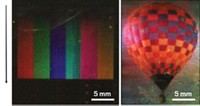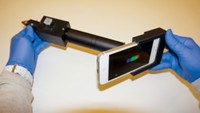Advertisement
Grab your lab coat. Let's get started
Welcome!
Welcome!
Create an account below to get 6 C&EN articles per month, receive newsletters and more - all free.
It seems this is your first time logging in online. Please enter the following information to continue.
As an ACS member you automatically get access to this site. All we need is few more details to create your reading experience.
Not you? Sign in with a different account.
Not you? Sign in with a different account.
ERROR 1
ERROR 1
ERROR 2
ERROR 2
ERROR 2
ERROR 2
ERROR 2
Password and Confirm password must match.
If you have an ACS member number, please enter it here so we can link this account to your membership. (optional)
ERROR 2
ACS values your privacy. By submitting your information, you are gaining access to C&EN and subscribing to our weekly newsletter. We use the information you provide to make your reading experience better, and we will never sell your data to third party members.
Imaging
A hacked Blu-ray player and a drop of blood create high-res images
Blood cells focus light in low-cost computational imaging system that is on par with a microscope
by Neil Savage, special to C&EN
April 20, 2022
| A version of this story appeared in
Volume 100, Issue 14

By hacking a Blu-ray drive and smearing blood on a sensor, researchers have created an inexpensive imaging system for studying microscopic samples, including measuring bacterial growth and doing urinalysis (ACS Sens. 2022, DOI: 10.1021/acssensors.1c02704).
Getting sharp images of a whole slide using a conventional optical microscope can require manually refocusing the microscope repeatedly over different parts of the sample—a time-consuming process. And scanners that can automatically image a whole sample at high resolution are expensive, costing $50,000 to $300,000. So Guoan Zheng, who runs the Smart Imaging Lab at the University of Connecticut, and his colleagues were looking for a way to perform such imaging quickly and cheaply.
They turned to computational imaging, which overcomes the limits of an optical system using techniques such as collecting phase information from reflected light. A computer can then use that information to refocus a picture after it’s been taken or construct a 3D image of a sample.

To make an inexpensive system, Zheng and his team decided to repurpose a Blu-ray disc player: The lasers inside provide a light source, and the slowly rotating disc drive allows images to be taken at multiple angles.
The researchers installed a sensor under the light source but then needed a way to scatter the light into a pattern the computer could process. Looking for a material that was cheap and available, Zheng hit upon the idea of pricking his finger and smearing his own blood on the sensor. The blood cells naturally spread out in a thin layer and are of the right size to scatter the incoming light in a random pattern, which the computer uses to reconstruct an image of the entire sample.
Their device has resolution comparable to an objective lens with 20×–46× magnification, over a theoretically unlimited area, and can capture 200–400 images in under 15 s. The group’s computer takes about 10 min to process the data into usable images, but Zheng hopes he can reduce that to under 1 min by using a computer with a more powerful graphics processing chip.
The team used their device to see microscopic uric acid and calcium oxalate crystals in urine samples as well as blood cells and blood parasites in a blood sample, all of which are useful in diagnostics. They also imaged bacterial colonies in a dish without having to worry about manually refocusing.
Aydogan Ozcan, a bioengineer at the University of California, Los Angeles, says that the research was interesting, and “it would be even more interesting to perhaps switch to microparticles to create similar computational imaging systems, which could be more sterile, durable, and last longer.”
Zheng says that engineering a surface with nanoscopic light-scattering features could yield similar results, but that would add to the cost of the system. The system wouldn’t necessarily require human blood: his team also tried using fish blood purchased from a local market and found that worked as well.





Join the conversation
Contact the reporter
Submit a Letter to the Editor for publication
Engage with us on Twitter